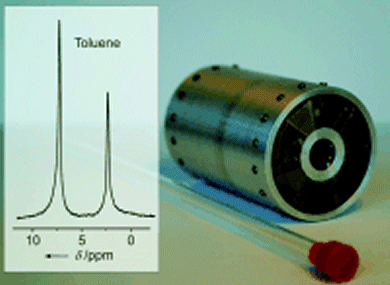Lightweight, Handy Magnets for Portable NMR Spectrometers
High-resolution nuclear magnetic resonance (NMR) spectrometry is one of the most powerful analytical tools for the precise determination of molecular structures and dynamics. To attain a high resolution, very strong magnetic fields are required, which are produced by superconducting electromagnets. Federico Casanova and his co-workers at the RWTH In Aachen (Germany) have now developed a light, permanent magnet that is suitable for NMR and fits in the palm of your hand. As the researchers report in the journal Angewandte Chemie, this could represent the cornerstone for portable, high-resolution NMR instruments.
Permanent Versus Supercondicting
In the 1960s and 1970s, NMR spectrometers used permanent magnets, which were not as massive as the superconducting magnets used today. With modern, improved permanent magnets, it should theoretically be possible to build handy, robust devices. This would make it possible to obtain NMR spectra that are about a third as sensitive as those obtained with standard-sized superconducting magnets. “This would be an acceptable concession for a small and portable NMR system,” says Casanova. “However, there is one problem: As the magnet gets smaller, the dimensions of the homogenous (uniform) magnetic field also decrease, making the sample volume smaller. Reduction of the sample volume affects the signal-to-noise ratio.”
Unusually Homogeous
The Aachen team has now developed a small permanent magnet weighing only 500 g with an unusually homogenous magnetic field that allows a standard-sized NMR tube to be used. Their success is due to a Halbach array: individual magnetic blocks are assembled into a cylinder so that the direction of their magnetization is tuned to produce an especially homogenous field within the cylinder. The researchers connect three Halbach rings whose diameter is optimized to compensate for the distortion of the magnetic field at the ends of the cylindrical inner chamber. In this way a sufficiently large homogenous magnetic field is produced inside the cylinder, which is large enough for a standard NMR tube. To even out the inhomogeneities originating from the granularity of the magnetic material, each ring consists of trapezoidal magnetic blocks with gaps in between. Inside the gaps are rectangular magnetic blocks that can be displaced radially to mechanically adjust (“shim”) the magnetic field.
“Spectra we obtained show that our miniature magnet is suitable for high-resolution NMR spectroscopy with standard-sized sample tubes,” reports Casanova. “It would be easy to transport together with the spectrometer. This could allow high-resolution NMR spectroscopy to develop into a portable analytical technique for use on samples in the field.”
- Small Magnets for Portable NMR Spectrometers
E. Danieli, J. Perlo, B. Blümich, F. Casanova,
Angew. Chem. Int. Ed. 2010, 49, 4133–4135.
DOI: 10.1002/anie.201000221
E. Danieli, J. Perlo, B. Blümich, F. Casanova,
Angew. Chem. 2010, 122, 4227—4229.
DOI: 10.1002/ange.201000221




